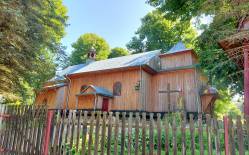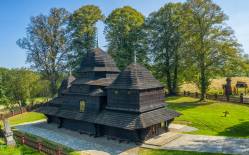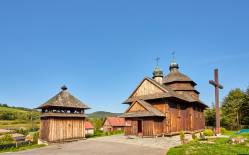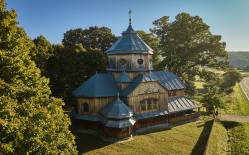The wooden Greek-Catholic tserkva of St. Demetrius the Great Martyr in Czarna survived the turmoil of the post-war period owing to the local community which did not allow the church to be transformed into a store house or to be demolished. Indeed, the people relocated to Czarna from Sokal and Krystynopol experienced the injustice of the post-war deportation and as a result they respected the cultural heritage of those who in 1951 were resettled from here to eastern Ukraine.
The tserkva was built in 1834 and today is used as the parish church of the Elevation of the Holy Cross.
The three-part log tserkva is oriented eastward. The front façade of the narthex features a characteristic classicist portico with a triangular gable end supported on six fluted Doric columns. All the parts of the building are covered with gable roofs. Over the nave we can see an octagonal turret with a Greek cross on top. The flat ceiling which can be seen inside was suspended below the original structure.
The classicist iconostasis from 1882 has been preserved. It was moved to the back of the chancel. There is an interesting representation of Christ Pantocrator, in Deisis row, bringing to mind late Baroque art from Lviv. The Royal Doors have not been preserved. The rood beam supports a 19th century rural-style crucifix. On the wall we can see the cross which originally was at the top of the iconostasis. Other artefacts from the tserkva are in the holdings of the Castle Museum in Łańcut; these include the altar cross ornamented with mirrors from 1887, a 19th century procession float and a figure of the Holy Mother. In the main nave we can see a 19th century painting of Christ carrying the cross, a baptismal font with a cover, from the 1600s, brought from the destroyed tserkva in Lipie, and a 17th century icon of Our Lady of Providence found in Michniowiec. In the side altar there are icons of the Mother of God Pokrov, and of St. Demetrius. On the left there is an altar with an icon of St. Nicholas and a scene of baptism in the Jordan. On the northern wall of the nave there are paintings: The Visions of St. Margaret, and The Sermon on the Mountain. Other artefacts here include a Baroque sculpture of the Crucifixion Group and figures of Sts. Peter and Paul, brought from the church in Waręż (today Variazh in Ukraine).
To the right of the tserkva we can see a figure of the Pensive Christ. Other features nearby include an open work post-and-beam belfry from the 1970s, and a plaque in memory of the people resettled from the Hrubieszów and Tomaszów Districts.
Photo: Krystian Kłysewicz
Gallery
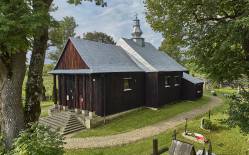
Recommended venues on the Trail



This website has been modernized with the financial support of the European Union under the Cross-Border Cooperation Programme Poland-Belarus-Ukraine 2014-2020. The responsibility for its content lies solely with the Podkarpackie Regional Tourism Board and cannot, in any case, be treated as a reflection of the position of the European Union, the Managing Authority, or the Joint Technical Secretariat of the Cross-Border Cooperation Programme Poland-Belarus-Ukraine 2014-2020.










